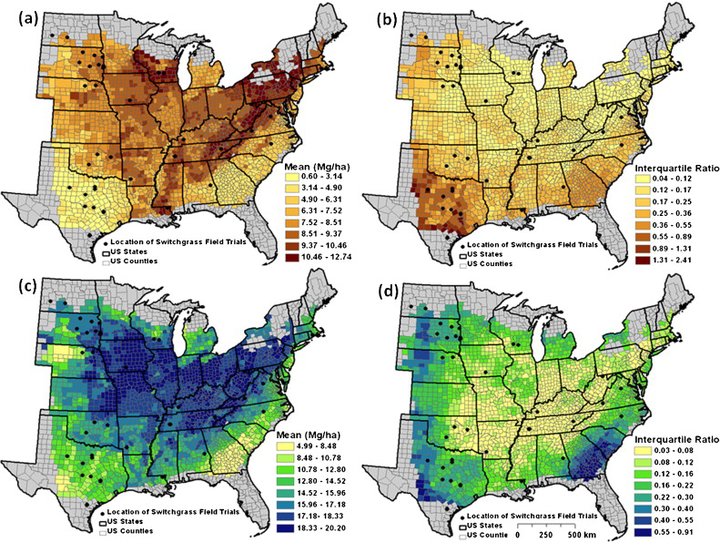 Figure 3 from the publication, “Mean predicted switchgrass yield (Mg/ha) from 1970 to 2008 for (a) upland and (c) lowland cytotypes and variability in switchgrass yield expressed as interquartile ratio (interquartile range/median) for (b) upland and (d) lowland cytotypes. Counties shown in gray fell outside the precipitation and temperature conditions used to parameterize our GAM models or are at the extremes of the variables outside the confidence in the GAM models.”
Figure 3 from the publication, “Mean predicted switchgrass yield (Mg/ha) from 1970 to 2008 for (a) upland and (c) lowland cytotypes and variability in switchgrass yield expressed as interquartile ratio (interquartile range/median) for (b) upland and (d) lowland cytotypes. Counties shown in gray fell outside the precipitation and temperature conditions used to parameterize our GAM models or are at the extremes of the variables outside the confidence in the GAM models.”Abstract
The U.S. Renewable Fuel Standard calls for 136 billion liters of renewable fuels production by 2022. Switchgrass (Panicum virgatum L.) has emerged as a leading candidate to be developed as a bioenergy feedstock. To reach biofuel production goals in a sustainable manner, more information is needed to characterize potential production rates of switchgrass. We used switchgrass yield data and general additive models (GAMs) to model lowland and upland switchgrass yield as nonlinear functions of climate and environmental variables. We used the GAMs and a 39-year climate dataset to assess the spatio-temporal variability in switchgrass yield due to climate variables alone. Variables associated with fertilizer application, genetics, precipitation, and management practices were the most important for explaining variability in switchgrass yield. The relationship of switchgrass yield with climate variables was different for upland than lowland cultivars. The spatio-temporal analysis showed that considerable variability in switchgrass yields can occur due to climate variables alone. The highest switchgrass yields with the lowest variability occurred primarily in the Corn Belt region, suggesting that prime cropland regions are the best suited for a constant and high switchgrass biomass yield. Given that much lignocellulosic feedstock production will likely occur in regions with less suitable climates for agriculture, interannual variability in yields should be expected and incorporated into operational planning.